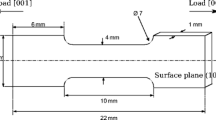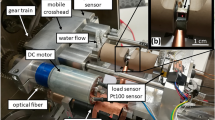Abstract
The present study unravels details of the micromechanical behavior of a micro-specimen made of IF-steel. A triangular prism is machined via focused ion beam (FIB) and contains two ferritic grains. Four experimental tools are integrated to identify the material’s crystal parameters: (i) an optical confocal microscope captures height profile images, (ii) an in-situ tensile stage prescribes the loading history to the macro-specimen, (iii) a global Digital Image Correlation (DIC) algorithm measures the 3D surface displacement fields, and iv) an extension of Integrated-DIC for 3D displacement fields is implemented to assess the micromechanical behavior. It is demonstrated that with this methodology the identification of the boundary conditions and crystal plasticity parameters is successfully achieved.
Access provided by CONRICYT-eBooks. Download conference paper PDF
Similar content being viewed by others
Keywords
- Digital image correlation
- Crystal plasticity
- Parameter identification
- In-Situ testing
- Digital height correlation
- Integrated digital image correlation
8.1 Introduction
The mechanical properties of materials often originate from physical and multi-scale phenomena that are due to complex and heterogeneous microstructures. One of the first methods to consider heterogeneous media for computing macro-mechanical responses is based on homogenization. In order to solve this problem micromechanical frameworks have been developed for elastic materials and in elasto-plasticity. Due to complex behaviors and the difficulty to observe and measure at the microscale the main challenge remains the identification of the constitutive parameters.
As products become smaller and smaller, accurate prediction of their mechanical behavior requires explicitly modeling of the individual crystals that constitute the material. Crystal plasticity (CP) models, which model dislocation densities instead of discrete dislocations, have been successful applied, e.g., to predict plastic hardening mechanisms. A key challenge of CP models, however, is that their model parameters can only be identified indirectly from their effect on the (microscopic) deformation fields. To this end, a novel integrated digital image correlation (IDIC) approach to identify the material’s crystal parameters is introduced, in which the three-dimensional surface deformation fields of a micro-tensile specimen are correlated by optimizing the parameters in a CP simulation.
The lattice structure (e.g., FCC, BCC) is considered to derive the constitutive equations for single crystals. The present study aims at coupling experimental and numerical results and provides a compromise between a reasonable computation time and a sufficiently small scale to achieve the observation of the micromechanical behavior in a material with real engineering applications. Digital Image Correlation enables full displacement and strain fields to be measured and provides insight into the micromechanics of solids. Imaging systems capable of higher magnifications allow the heterogeneity of the micromechanical response to be evaluated.
The objective of this study is to perform an investigation at the microscale and to identify the material parameters of a crystal plasticity model with Integrated Digital Image Correlation (IDIC) [1,2,3,4,5,6]. Figure 8.1 shows the designed identification procedure. Initially, the crystallographic features, i.e., phase, grain (size, number and orientation) and the geometry of the studied volume are assessed and lead to the design of a representative 3D numerical model. Secondly, the out-of-plane displacement holds essential information regarding the active slip systems. Therefore an experimental method is introduced that utilizes confocal microscopy combined with a 3D surface global DIC formulation to quantify full three-dimensional displacement fields of the specimen surface and use these 3D data to extract boundary conditions and identify crystal plasticity parameters [7]. Because of the relatively high noise level computations are run with stabilized boundary conditions. Finally, the sought parameters are identified with integrated-DIC that combines all experimental data, i.e., the surface height profiles, constitutive model, and crystallographic features.
Schematic view of the methods used herein to extract boundary conditions and crystal plasticity parameters [7]
8.2 Results and Conclusion
The IDIC approach works directly on the height profiles. It includes: (i) micro-fabrication, by means of careful FIB milling, of a 12.0 × 4.0 × 3.5 μm3 triangular specimen containing two crystals, thus only 1 grain boundary, (ii) loading in an in-situ micro-tensile stage under simultaneous optical microscopy to measure surface height profiles, (iii) global DIC measurement of the 3D boundary displacements conditions of the CP simulation, and (iv) IDIC correlation of the surface topographies using simulated CP deformation fields. It is demonstrated that with this methodology the identification of the boundary conditions and crystal plasticity parameters is successfully achieved [7]. The concept proposed herein is very general and can be applied to any micromechanical experiment aiming to characterize a constitutive law describing a micromechanical behavior. The technique gives new insights into the micro-mechanical behavior with the combination of images and loads based on a methodology that can cope with high noise levels.
References
Neggers, J., Hoefnagels, J.P.M., Geers, M.G.D., Hild, F., Roux, S.: Time-resolved integrated digital image correlation. Int. J. Numer. Methods. Eng. 103(3), 157–182 (2015)
Ruybalid, A.P., Hoefnagels, J.P., Sluis, O., Geers, M.G.: Comparison of the identification performance of conventional FEM updating and integrated DIC. Int. J. Numer. Methods. Eng. 106(4), 298–320 (2015)
Bergers, L.I.J.C., Hoefnagels, J.P.M., Geers, M.G.D.: Characterization of time-dependent anelastic microbeam bending mechanics. J. Phys. D. Appl. Phys. 47(35), 355306 (2014)
Hild, F., Bouterf, A., Chamoin, L., Leclerc, H., Mathieu, F., Neggers, J., Pled, F., Tomičević, Z., Roux, S.: Toward 4D mechanical correlation. Adv. Model. Simul. Eng. Sci. 3(1), 17 (2016)
Kleinendorst, S., Hoefnagels, J.P.M., Geers, M.G.D., 2017: Mechanical Shape Correlation: an integrated image correlation approach (submitted for publication)
Blaysat, B., Hoefnagels, J.P., Lubineau, G., Alfano, M., Geers, M.G.: Interface debonding characterization by image correlation integrated with double cantilever beam kinematics. Int. J. Solids. Struct. 55, 79–91 (2015)
Bertin, M., Du, C., Hoefnagels, J.P., Hild, F.: Crystal plasticity parameter identification with 3D measurements and integrated digital image correlation. Acta. Mater. 116, 321–331 (2016)
Author information
Authors and Affiliations
Corresponding author
Editor information
Editors and Affiliations
Rights and permissions
Copyright information
© 2018 The Society for Experimental Mechanics, Inc.
About this paper
Cite this paper
Hoefnagels, J.P.M., Bertin, M., Du, C., Hild, F. (2018). Crystal Plasticity Parameter Identification by Integrated DIC on Microscopic Topographies. In: Baldi, A., Considine, J., Quinn, S., Balandraud, X. (eds) Residual Stress, Thermomechanics & Infrared Imaging, Hybrid Techniques and Inverse Problems, Volume 8. Conference Proceedings of the Society for Experimental Mechanics Series. Springer, Cham. https://doi.org/10.1007/978-3-319-62899-8_8
Download citation
DOI: https://doi.org/10.1007/978-3-319-62899-8_8
Published:
Publisher Name: Springer, Cham
Print ISBN: 978-3-319-62898-1
Online ISBN: 978-3-319-62899-8
eBook Packages: EngineeringEngineering (R0)





